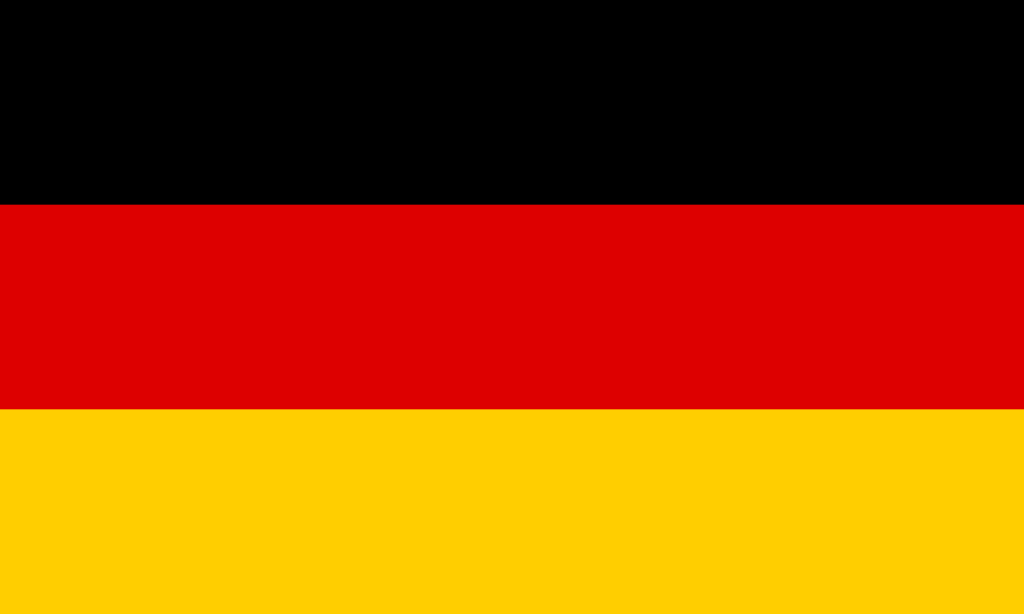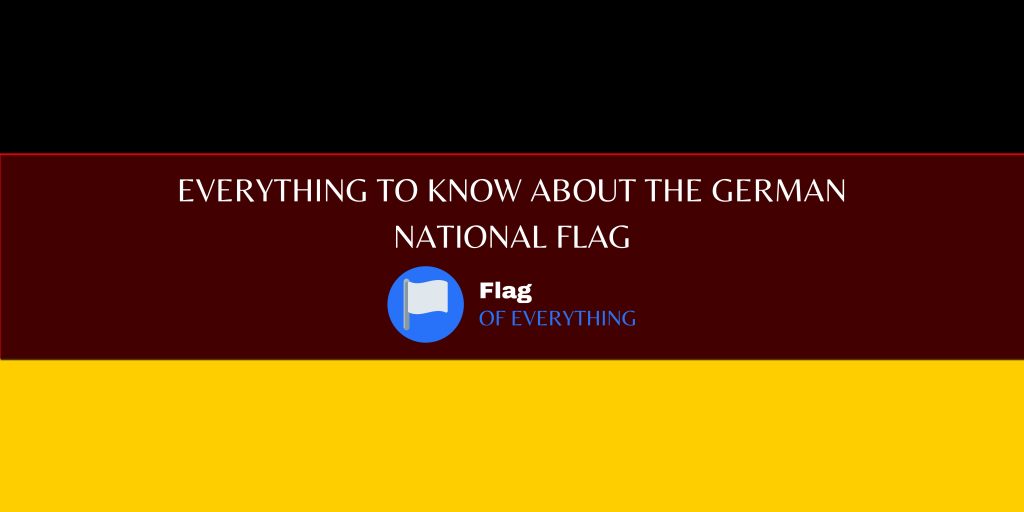The German national flag often referred to as the “Flag of Germany” or “Deutsche Flagge”, with its iconic black, red, and gold bands, is a symbol that resonates with history, unity, and change. In this exploration, we aim to uncover the meanings behind the three colors on the German flag and address common questions regarding its history and official status.
The German national flag consists of three horizontal bands: black on the top, red in the middle, and gold (or yellow) on the bottom. These colors have historic significance. Black symbolizes the determination of the German people, red represents the sacrifices made for freedom and unity, and gold (or yellow) signifies a bright and hopeful future.
Germany has two official flags due to historical reasons and the reunification of East and West Germany in 1990. The most recognized flag is the tricolor (black, red, and gold), which represents the unified Germany. The other official flag is the federal flag, which includes the black-red-gold tricolor with the national coat of arms, representing the federal government.
Before World War II and the division of Germany, the flag was the black-red-gold tricolor. However, during the Nazi era, the swastika flag, featuring a red background with a white circle and a black swastika in the center, was used. After World War II, Germany reverted to the black-red-gold tricolor.
The official German flag is the tricolor, consisting of horizontal bands of black, red, and gold (or yellow). It is a symbol of modern Germany and represents the country’s unity and democratic values.

What is the shape of the german national flag?
The flag’s design is simple yet powerful, reflecting the values of the German people and their commitment to democracy and unity.
The German national flag features sharp and keen lines in its design. It consists of three horizontal stripes of black, red, and gold, with well-defined edges, representing a strong and clear visual identity for the nation.
The German national flag embraces angularity through its rectangular shape and the sharp contrast between its three horizontal stripes. The flag’s sides form right angles, symbolizing order, stability, and adherence to principles.
The German national flag does not display narrowing. Its width remains consistent from top to bottom, maintaining a balanced and harmonious appearance, signifying unity.
The German national flag does not prominently incorporate curvature or curves. The flag’s design relies on straight lines and bold color contrasts, emphasizing clarity and simplicity.
The German national flag does not emphasize roundness in its design. The flag’s elements and colors are predominantly linear and angular, reflecting straightforward symbolism and ideals.
The German national flag is characterized by straightness in its shape and the division between its black, red, and gold horizontal stripes. These straight lines represent Germany’s commitment to order, discipline, and adherence to principles.
The German national flag does not showcase stratification. It consists of three equal horizontal stripes, making it a straightforward and unified design that underscores the importance of national unity and equality.
How wide is the german national flag?
The width of the German national flag holds a significant dimension, measuring approximately 4.92 feet or 1.5 meters in standard scales. This width allows the flag to be prominently displayed during national events and celebrations, symbolizing Germany’s history, unity, and democratic values.
How high is the german national flag?
The height of the German national flag stands at around 3.28 feet or 1 meter in standard scales. This balanced height complements its width, ensuring that the flag’s design is presented with precision and respect, embodying Germany’s commitment to democracy and European unity.
What is the aspect ratio of the german national flag?
The German national flag adheres to an aspect ratio of 3:5, creating a harmonious and visually appealing design. This carefully chosen ratio ensures that the flag’s proportions remain faithful to its intended representation, symbolizing Germany’s role in Europe and the world.
What colors does the german national flag use?
The german national flag has a total of 3 colors: black, red and gold(or yellow). The exact color codes are given in the table below.
| Black | Red | Gold (or Yellow) | |
| HEX | #000000 | #DD0000 | #FFCC00 |
| RGB | 0, 0, 0 | 221, 0, 0 | 255, 204, 0 |
| CMYK | 0, 0, 0, 100 | 0, 100, 100, 0 | 0, 12, 100, 5 |
| Pantone | Black | 485 | N. A. |
| RAL | 9005 | 3020 | 2007 |
History of the german national flag
The history of the German national flag is complex and marked by significant historical events. The flag’s design, consisting of three horizontal stripes in black, red, and gold, traces its origins to the 19th century. It was officially adopted as the national flag of Germany in 1919 during the Weimar Republic and has undergone variations over time. Today, it symbolizes a united Germany, democratic values, and European cooperation.
When was the german national flag created?
When was the German national flag created?
The modern version of the German national flag, with the black, red, and gold horizontal stripes, was officially adopted on May 23, 1949. This date marks the founding of the Federal Republic of Germany (West Germany), a significant step towards reunification and democracy in post-war Germany.
Who made the german national flag?
The design of the modern German national flag, with its black, red, and gold stripes, reflects the aspirations of the German people for unity and democracy. It was not created by a specific individual but emerged from the collective desire to represent a democratic and united Germany.
How much did it cost to create the german national flag?
The creation of the German national flag was not associated with a specific monetary cost, as it was not commissioned to an individual or entity for payment. Instead, it symbolizes the nation’s democratic values, unity, and commitment to peace.
What is the meaning of the german national flag?
The colors on the German national flag encapsulate the nation’s complex history, its determination to overcome adversity, and its commitment to unity and progress. The flag serves as a powerful symbol of modern Germany, embodying the nation’s values and aspirations. The german flag does not have any symbols.
The colors on the german national flag and their meanings are shown below.
- Black: The black color on the German flag symbolizes the determination and resilience of the German people. It represents their commitment to overcoming challenges and forging a strong and unified nation.
- Red: The red color on the flag represents the sacrifices made by the German people throughout history, particularly in their quest for freedom and unity. It serves as a reminder of the bloodshed and struggles endured on the path to a united Germany.
- Gold (or Yellow): The gold (or yellow) color on the flag signifies hope and a bright future. It reflects the aspirations of the German people for a prosperous and peaceful nation. It stands as a symbol of the optimism and positivity that have driven Germany’s progress.
How to fly the german national flag?
The German national flag is flown with great respect and accordance with the nation’s customs and traditions. Proper flag etiquette includes displaying the flag prominently during national holidays and events, as well as raising it briskly and lowering it ceremoniously. The flag’s design represents Germany’s democratic principles and commitment to European cooperation, and its proper display is an embodiment of the nation’s pride and unity.
Raising and displaying the German national flag is an important way to show national pride and unity. The most important etiquette of the german flag is described below.
- Positioning: Place the flagpole securely in the ground or on a suitable mounting structure, ensuring that the flag remains visible and unobstructed.
- Orientation: When raising the flag, make sure the black band is at the top, followed by the red band in the middle, and the gold (or yellow) band at the bottom.
- Raising and Lowering: Raise the flag briskly in the morning and lower it ceremoniously at sunset. If you choose to keep it up overnight, ensure it is properly illuminated.
- Respect: Handle the flag with care and avoid letting it touch the ground. It’s a symbol of the nation’s heritage and should be treated with respect.
Do german citizens respect the german national flag?
Yes. german citizens do respect the german national flag. Indeed, German citizens hold deep reverence for their national flag, which symbolizes the nation’s complex history and its journey towards democracy and European integration. Displaying the flag with honor and pride is a testament to the German people’s commitment to democratic values and unity.
Is the german national flag disrespectful?
No, the german national flag is not disrespectful. On the contrary, it is a revered symbol of Germany’s commitment to democracy, peace, and European cooperation. Treating the flag with dignity and respect reflects the nation’s values and reverence for its history and democratic principles.
What flags are similar to the german national flag?
Below are the national flags that resemble the german national flag.
- Flag of Belgium: The flag of Belgium also consists of three vertical bands of black, yellow, and red. However, the orientation and order of the colors are different from the German flag.
- Flag of South Africa: The flag of South Africa features six different colors, including black, red, and gold, but they are arranged in a unique pattern, and the flag is predominantly multicolored.
- Flag of Belgium (Vertical): Belgium also has a vertical tricolor flag with black, yellow, and red bands arranged from left to right.

